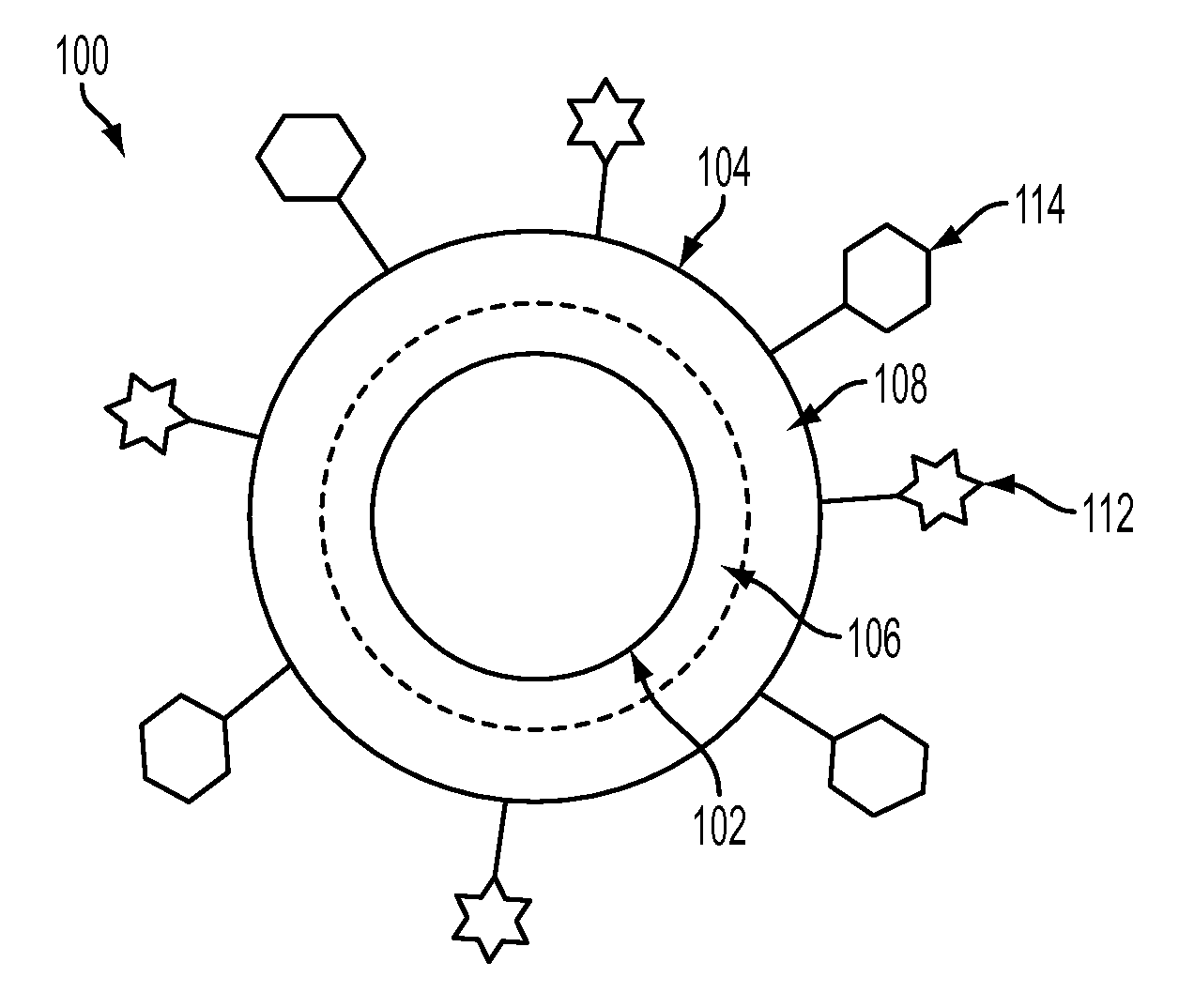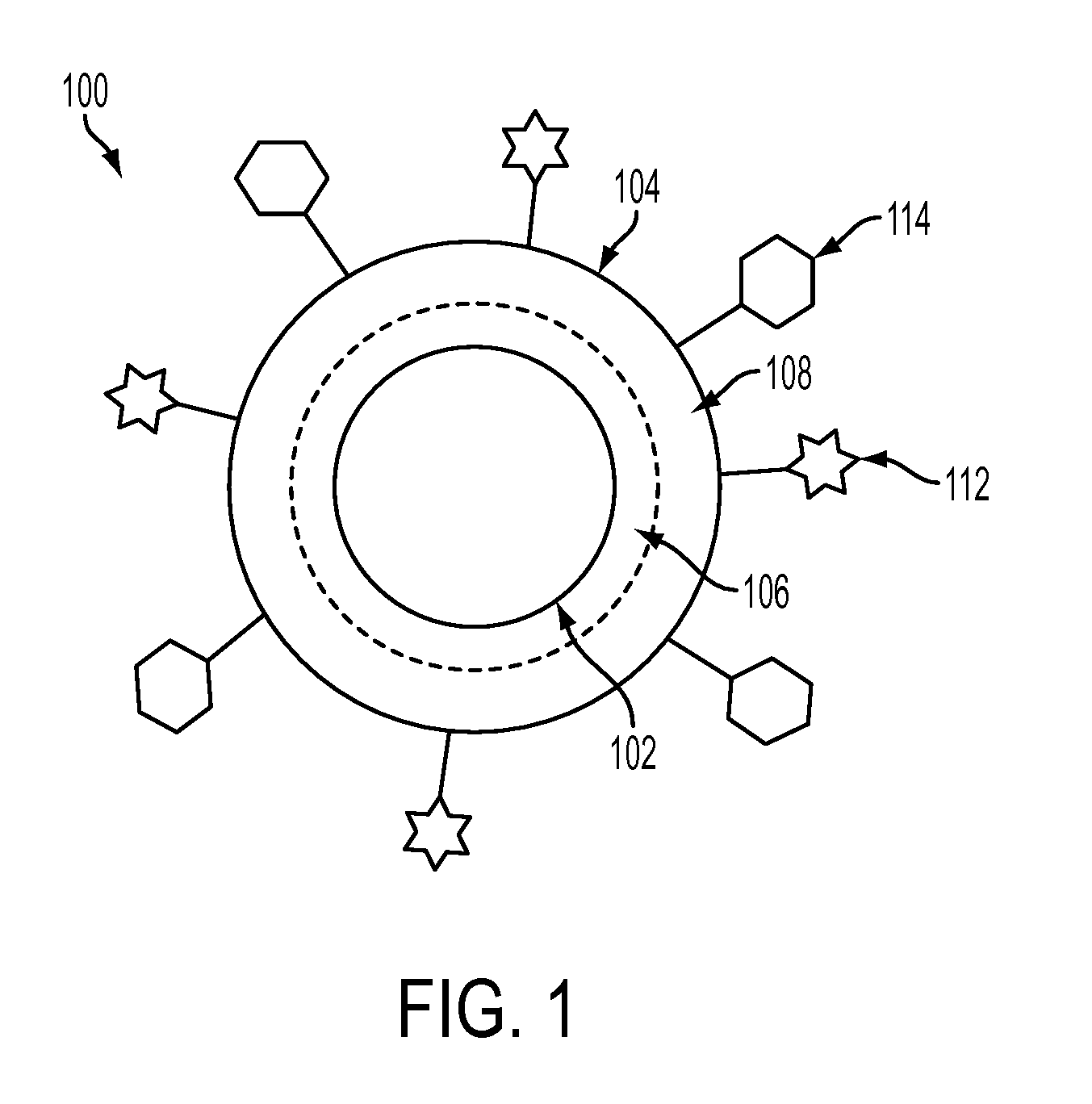Nanoparticle Based Immunological Stimulation
a delivery system and nanoparticle technology, applied in the direction of antibody medical ingredients, carrier-bound antigen/hapten ingredients, immunological disorders, etc., can solve the problems of single adjuvant formulation that is universally effective, the development of new adjuvants has not kept up with the increasing demand for their use, and the antigen (i.e., pieces of virus or bacteria) does not produce an effective immune respons
- Summary
- Abstract
- Description
- Claims
- Application Information
AI Technical Summary
Problems solved by technology
Method used
Image
Examples
example 1
[0090]The results of Example 1 are also discussed in Pusic, et al., Blood stage meroziote surface protein conjugated to nanoparticles induce potent parasite inhibitory antibodies, Vaccine 29 (2011) 8898-8908, which is incorporated by reference in its entirety. Water soluble nanoparticles were tested as a vaccine vehicle / platform to enhance the immunogenicity of antigens in adjuvant-free immunizations using malaria parasite recombinant blood stage merozoite protein, rMSP1-42 as a model vaccine candidate. The term “adjuvant-free immunization” as used herein refers to immunizations free from conventional adjuvants such as Freund's Complete Adjuvant, which are usually mixed in the presence of oil. Specifically, a delivery system including nanoparticles less than 10 nanometers (nm) bound to recombinant malaria vaccine antigen, rMSP1-42, was tested as a malaria vaccine delivery platform.
[0091]In this exemplary embodiment, water soluble CdSe / ZnS core / shell nanospecies were surface modified...
example 2
[0130]This example is similar to Example 1 but uses iron oxide (IO; Fe2O3) nanoparticles (<15 nm) as a vaccine delivery platform to enhance the immunogenicity of antigens without adjuvants. rMSP1 was used as the model vaccine conjugated to IO nanoparticles to form a rMSP1-IO nanostructure. The IO nanoparticles used in this example are commercially available from Ocean Nanotech, LLC under catalog number SHP. This family of iron oxide nanoparticles are water soluble nanoparticles with diameters ranging from 1 to 100 nm And are carboxyl functionalized on the surface. This example shows that rMSP1-IO was immunogenic in mice and its immunogenicity was equal to that obtained with rMSP1 administered with a clinically acceptable and commercially available adjuvant, Montanide ISA51. Rabbits and Aotus monkeys immunized with rMSP1-IO also achieved comparable immune response that induced significant levels of antibodies with efficient parasite inhibition. There were no apparent local or systemi...
example 3
[0163]Silver, Gold, and CuInS2 based delivery systems were also tested in various species of animal to determine if they were effective in obtaining immunological responses. The studies were conducted in a manner similar to Examples 1 and 2. Four (4) antigens were tested for antibody production: BSA, human IgG, ovalbumin, and recombinant Plasmodium falciparum mesosporozoite protein (rMSP). The results of the nanoparticle adjuvanted antibody production are summarized in Table 4.
TABLE 4Antibody production in various animals (covalent conjugated Ag on NM surface)Host AnimalAntigenNanomaterialAb titer (dilution)BoosterSW micerMSP (recombinant P falciparum protein)Quantum dots (8.5 nm)0587(1:31,250)3SW micerMSP (recombinant P falciparum protein)Iron Oxide (10 nm)0.638(1:1250)3SW miceOvalbumin, 100 uL of 5 mg / mLCuInS2 (5 nm)0.605(1:6250)3NZ RabbitOvalbumin, 100 uL of 5 mg / mLAu (5 nm)0.381(1:6250)3NZ RabbitmIgG (mouse IgG), 100 uL, 5 mg / mLIron oxide (10 nm)0.338(1:640,000)3NZ RabbitmIgG (m...
PUM
| Property | Measurement | Unit |
|---|---|---|
| size | aaaaa | aaaaa |
| size | aaaaa | aaaaa |
| pore diameter | aaaaa | aaaaa |
Abstract
Description
Claims
Application Information
 Login to View More
Login to View More - R&D
- Intellectual Property
- Life Sciences
- Materials
- Tech Scout
- Unparalleled Data Quality
- Higher Quality Content
- 60% Fewer Hallucinations
Browse by: Latest US Patents, China's latest patents, Technical Efficacy Thesaurus, Application Domain, Technology Topic, Popular Technical Reports.
© 2025 PatSnap. All rights reserved.Legal|Privacy policy|Modern Slavery Act Transparency Statement|Sitemap|About US| Contact US: help@patsnap.com



